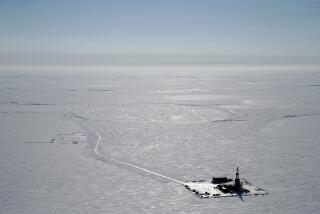GAO says Shell’s Arctic spill response plans might be lacking
- Share via
WASHINGTON — Days after the Obama administration approved Royal Dutch Shell’s oil spill response plan for drilling in Arctic waters off the Alaska coast, an independent federal report said that Shell’s plan fails to take into account the risks unique to oil production in harsh, icy offshore conditions.
After years of delays, Shell’s plan to drill for oil in the Beaufort Sea as early as this summer has gained momentum as it won necessary permits from the Interior Department.
Shell’s project would be the first oil drilling in U.S. Arctic waters since the early 1990s. But environmentalists, some Alaska native groups and members of Congress have argued that there are not enough safeguards in place to contain a well blowout or clean up a spill in rough Arctic conditions.
The report issued Friday by the Government Accountability Office cited Interior Department and Coast Guard officials who said “that a well containment response in Alaskan waters might face certain risks that could delay or impede a response to a blowout.”
The report raised questions about whether wellhead equipment could withstand ice that scoured along the sea floor.
Interior officials told the report’s authors that if a blowout occurred after the drilling season ended in October, the sea’s surface ice could make it difficult for Shell’s icebreakers to get to the accident site and install containment equipment.
In response to the report, Interior officials released a statement Friday saying that “exhaustive reviews of the plans” were conducted prior to the approvals and Shell will be held accountable for additional reviews and inspections “to ensure that all personnel and equipment are positioned and ready, if needed.”
Shell has spent nearly $4 billion and five years preparing to drill exploratory wells in the Beaufort Sea and nearby Chukchi Sea. It said it hopes to begin drilling as early as July 10 and continue until just before the onset of ice in October, with a brief halt in the late summer to allow for a hunt of bowhead whales by Alaska natives.
Shell has said that the chances of a blowout in the Arctic are smaller in part because pressure in the oil reservoirs is lower than in wells in the Gulf of Mexico, site of the disastrous Deepwater Horizon oil spill in 2010.
If a blowout did occur, Shell and the oil industry might not have enough boats and people in place to deal with it, the GAO report said.
The report said Shell officials “told us that additional personnel would be needed to respond to a subsea well blowout. Moving personnel to the site could delay a response, since harbors, airstrips and hotels necessary to support personnel are limited in number and size along Alaska’s northern shore. The facilities are also generally much farther from the drilling sites than they are in the Gulf of Mexico.”
Shell defended its drilling plans. Spokeswoman Kelly op de Weegh said, “We believe our plan, vessels and equipment are the Arctic standard. In addition to Arctic capping and containment systems, our three-tier response plan was specifically assembled to mitigate environmental impact in the hugely unlikely event of well control incident.”
More to Read
Sign up for Essential California
The most important California stories and recommendations in your inbox every morning.
You may occasionally receive promotional content from the Los Angeles Times.











